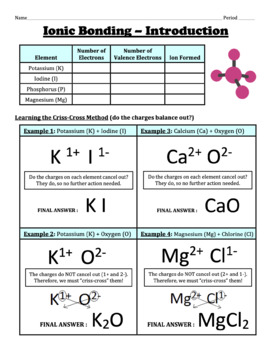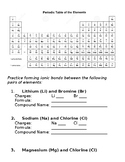

Thus, each atom in a molecule must be exposed to eight electrons: either through electron transfer (e.g.
Ion bonding practice full#
This means that atoms with 1 electron in their valence shell are ready to give up their electrons while those with a nearly full shell aren’t. In chemistry, the octet rule states that each atom is most stable when it contains a full valence shell of 8 electrons. (For more information on enzymes and cofactors, be sure to refer to our guide on enzymes.) d) Single and double bonds Since they are integrated into enzymes and are often critical for the enzyme’s function, these transition metals are referred to as cofactors. For this reason, transition metals can form two, three, or four coordinate covalent bonds with other atoms! Zinc, iron, and magnesium are examples of such metals that usually bond with enzymes inside our bodies. In this type of covalent bond, both electrons in the bond are donated by a single atom.ĭue to their unique orbital structure, transition metals can easily accept electrons from other atoms. A coordinate covalent bond, sometimes referred to as a dative bond, is a special subtype of covalent bond that often forms between transition metals. Recall that covalent bonds are simply bonds formed between atoms in which electrons are unevenly shared. For more information on this, be sure to refer to our guide on isomers. Molecules and chemical compounds can often be drawn in a variety of ways. This resonance form is highly unlikely to occur! In contrast, creating only single bonds in ozone would create formal charges of -1, -1, and +2, which are much higher formal charges. This is the relatively stable form of ozone, as the formal charges of each species are fairly low. One atom has a charge of 0, while the other two have charges of -1 and +1.


In the ozone molecule, each oxygen atom has a different formal charge. Thus, it can be calculated using the following equation:įormal charge = # valence electrons - nonbonding electrons - bonding electrons ÷ 2 Formal charge refers to the amount of “functional” charge an atom would have, assuming all electrons are shared equally. The most stable resonance form is one that provides the lowest formal charge of the atoms. The resulting combined configuration may be shown with a dashed line. The electrons within the molecule are said to be delocalized and can be found with equal probability within any of these resonance structures. In general, the bonds within such a molecule are assumed to be a combination of all of these resonance structures. A molecule that displays resonance may have electrons in any of these resonance configurations at any given time. When drawing the structure of an ion, be sure to add/subtract electrons to account for the charge. Step 1: Figure out how many electrons the molecule must have, based on the number of valence electrons in each atom. A resonance structure is an alternative model of covalent bonding. The following procedure will give you the correct Lewis structure for any molecule or polyatomic ion that has one central atom. One advantage to using a Lewis dot diagram is that resonance structures can be shown. Be sure to understand these terms well, as they will be high-yield on Test Day! At the end of this guide, there are also several MCAT-style questions you can use to test your knowledge. Throughout this guide, there will be several important terms marked in bold. Some exist between individual atoms of a molecule, while others exist between molecules. There are a variety of bonds, or attractive forces, that exist. Atomic bonds and intermolecular attractions are the foundation for many additional concepts in organic chemistry and biochemistry.Ĭhemical bonds are chemical interactions that create an attractive force between atoms or molecules. Understanding how atoms and molecules interact with each other is crucial for much of the chemistry section of the MCAT. What holds everything in the universe together? Why don’t atoms and molecules randomly split apart and float away? The answer lies in bonding and molecular interactions. Here are some different ways to draw aluminium oxide (Al 2 O 3).Part 1: Introduction to bonds and interactions What happens when the charges on the ions are not equal in magnitude? In aluminium oxide the charge on the positive metal ions is 3 + while the charge on the negative oxide ions is 2. In magnesium oxide, the charges on the metal and non-metal ions are equal and opposite. Magnesium oxide is not soluble in water because the attraction between the polar water molecules and the ions is not strong enough to break the ionic bonds between the magnesium and oxygen ions.It forms strong ionic bonds with any ions of opposite charge that fit close enough to it in the ionic lattice. In an ionic compound the metal ion doesn’t just form a bond with the ion it donated electrons to.The charge is distributed throughout the ion, the square brackets denote this.

You can use this to work out the charge of the ion. The group number on the periodic table tells you how many electrons there are in the outer shell of the atom.


 0 kommentar(er)
0 kommentar(er)
